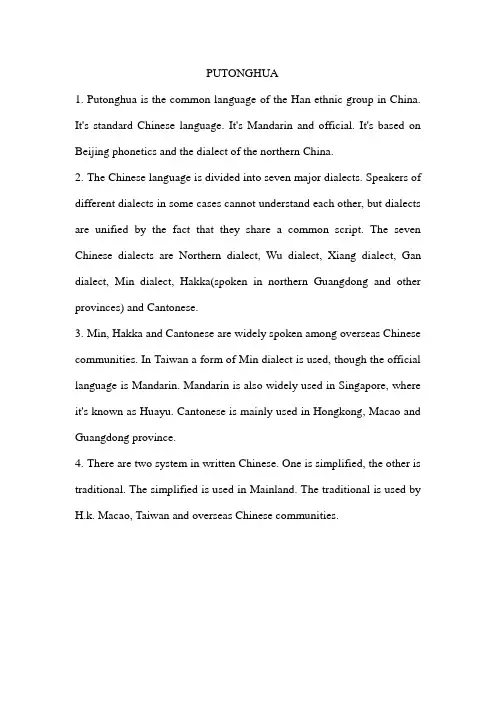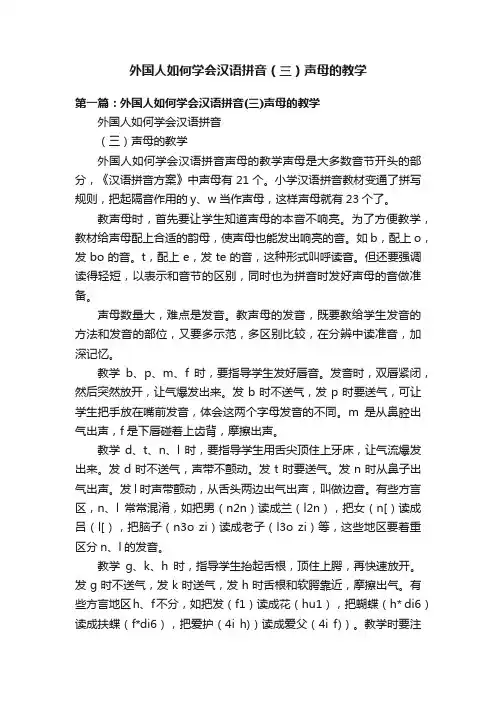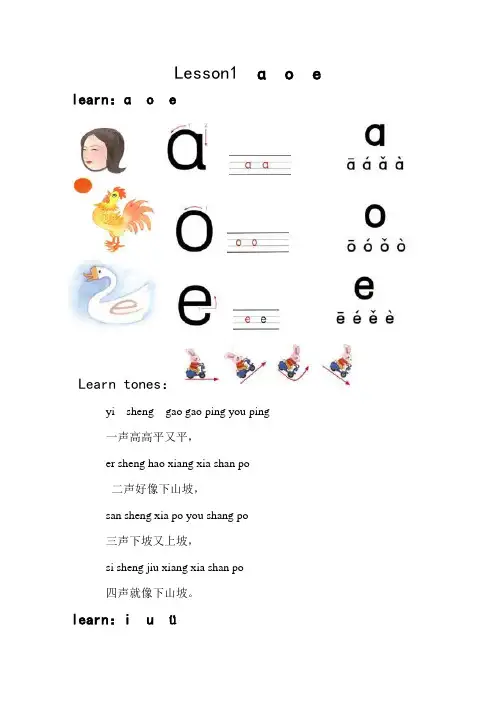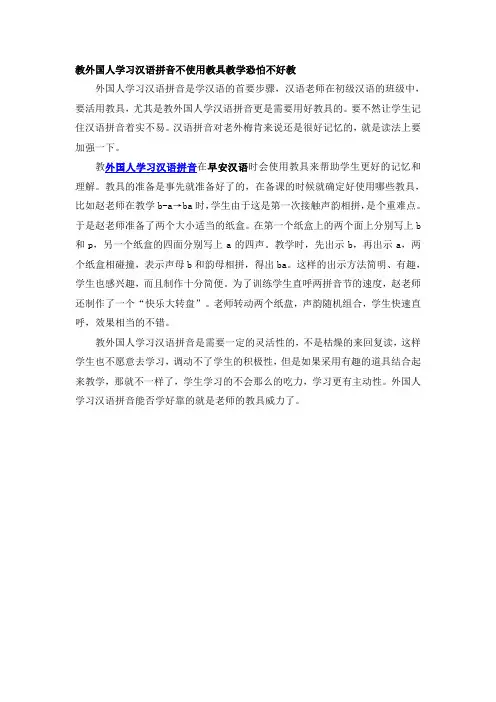教老外学汉语拼音-by Reshide
- 格式:ppt
- 大小:1.77 MB
- 文档页数:109

PUTONGHUA1.Putonghua is the common language of the Han ethnic group in China. It's standard Chinese language. It's Mandarin and official. It's based on Beijing phonetics and the dialect of the northern China.2.The Chinese language is divided into seven major dialects. Speakers of different dialects in some cases cannot understand each other, but dialects are unified by the fact that they share a common script. The seven Chinese dialects are Northern dialect, Wu dialect, Xiang dialect, Gan dialect, Min dialect, Hakka(spoken in northern Guangdong and other provinces) and Cantonese.3.Min, Hakka and Cantonese are widely spoken among overseas Chinese communities. In Taiwan a form of Min dialect is used, though the official language is Mandarin. Mandarin is also widely used in Singapore, where it's known as Huayu. Cantonese is mainly used in Hongkong, Macao and Guangdong province.4.There are two system in written Chinese. One is simplified, the other is traditional. The simplified is used in Mainland. The traditional is used by H.k. Macao, Taiwan and overseas Chinese communities.How do we learn pinyin well?1.Today we will learn pinyin.2.What is pinyin? Pinyin is the mark of phonetic notation for Chinese characters. It's made of three parts: initials, finals and tones.3.For example, pĭnyīn, nĭ hǎo, xièxiè, zaìjìan4.After learn three parts, we should be able to pronounce every single word.5.How do we learn pinyin?We divide our pinyin class into 10 classes.In the first or second class, firstly recognize all (three parts). Secondly, practice group by group. Thirdly, do some exercises. Steps: ①带读②解释③方法④放弃Mistakes:①发音部位②发音方法③莫名其妙ü的读法:i→üFirst, try to pronounce "i", and then your tongue stays here,gradually purse your lips.Try it yourself.ü的标调方法:When you see j q x y initial goes with ü, you can see u.INITIALS AND FINALSInitial Sounds:(22)These initial letters have the same pronunciation as in English:(f,l,m,s,(w),(y))•m-- (as in "man") n-- (as in "no") l-- (as in "letter")•f-- (as in "from") s-- (as in "student") w-- (as in "woman")The following initial letters have slight differences as noted below. If the comment calls for a strong puff of breath, old your open hand several inches from your mouth and make certain that you can actually "feel" the breath as you pronounce the letter.•p-- (as in "pun" or "pop") note: use a strong puff of breath•k-- (as in "cop") note: use a strong puff of breath•t-- (as in "top") note: use a strong puff of breath•b-- (as in "bum") note: no puff of breath•d-- (as in "dung") note: no puff of breath•g-- (as in "good") note: no puff of breath•h-- (as in "hot") note: slightly more aspirated than in English The following initial letters are the more difficult for English speakers:•z--(as in "friends")•c--(as in "bits")•s--(almost the same as the pronounce of "s' in English)•zh-- (as in "judge")•ch-- (as in "church", but with a strong puff of breath)•sh-- (as in "shirt")•r-- (as in "run")•j-- (as in "jeep")•q-- (like the "ch" in "cheese")•x-- (like the "sh" in "sheep")Final (Ending) Sounds:(39)The finals connect with the Intitial sounds to create the one syllable words that are the basis of the Chinese language.Although all Chinese words are one syllable, they are often combined to create terms made from several words.•-a (as in father)•-an (like the sounds of "John" or "angry")•-ang (like the sound of "under" or "rang' )•-ai (as in "high")•-ao (as in "how" or "out")•-o (like "aw")•-ou (like the "ow" in "low" or "boat")•-ong (like the "ung" in "lung" with a slight "oo" sound)•-e (sounds like "uh")•-en (like "un" in "open")•-eng (like the "ung" in "lung")•-ei (like a long "a" or the "ei" in "eight")•-er (like the "er" in "herd")•-i (like a long "e" or the "i" in "machine" or "see")•-ia ( like ya in "yard")•-ian (similar to "yen")•-iang(-i followed by ang)•-iao (like yow in "yowl")•-ie (like ye in "yes")•-in (as in "bin")•-ing (like "sing")•-iong (i merged with ong)•-iu (like yo in "yoga")•-u (like the "oo" in "loop")•-ua (u followed by a)•-uai (like wi in "wild")•-uan (u followed by an)•-uang (like wang in "twang")•-uang (u followed by eng, which exists only with zero initial as weng)•-ui (similar to "way")•-un (as in "fun")•-uo (as in "war")•-ü (First, try to pronounce "i", and then your tongue stays here, gradually purse your lips. Try it yourself)•-uan (ü followed by an, only with initials j,q,x)•-ue/üe ()•-un (ü with n, like French une)Rules of spelling1. The finals of zhi chi shi ri zi ci si are "i".2. As for finals beginning with "i" without initials:If there is no other vowel, just add 'y' to the beginning: yī, yīn,yīng.If there is another vowel or other vowels, remove 'i'and add 'y' to the beginning: ya(-ia); ye(-ie); yao(-iao); you(-iou); yang(-iang); yong(-iong) 3. AS for finals beginning with 'u' without initials:If there is no other vowel, just add 'w' to the beginning: wuIf there is another vowel or other vowels, remove 'u' and 'w' to the beginning: wa(-ua); wo(-uo); wan(-uan); wang(-uang); weng(-ueng); wai(-uai); wei(-uei); wen(-uen).4. When you see j q x y initial goes with ü,you can see u. For example, Ju; quan; xue; yu; yue; yuan; yun.5.Tone marks are marked on the vowels 'a o e i u ü' according to the order. For example, kāi zhāo. When the tone mark is on an 'i', the dot on the 'i' should be omitted. For example, jīn, tì, zhǐ.AS for finals iu and ui, we always put the tone marks on the latter. For example,diūniúhuīTONES1.DefinitionChinese is tone language. By tone language I mean the language in which every word has its specific tone or tones.2.ImportanceTones can distinguish meanings. Different tones have different meanings. For example, the two pinyin have the same initial and final. They are different only in tones. For example, mǎi and mài, māand mǎ.mǎi is the third tone and means to buy.mài is the fourth tone and means to sell.3.A vivid illustration of Chinese tones. (pitch graph of the 4 tones)The tone marks:mother Yes? (not found) Yes!What!In order to give you a better understanding, I will share you a pitch graph so that you will know what is tone like vividly.The bigger the number, the higher the pitch. The first tone is number 5. The second tone is from number 3 to number 5. The third tone is from number 2 to 1 and then goes from number 1 to number 2 to 4. The fourthtone is from number 5 to number 1.4.Where to place tone marks?Generally, put it on the major vowel of the "final". Then what's the major vowels? It's that one that appears ahead according to the order "a o e i u ü".Eg. mǎi kāi zhāo xiè dōu5.The neutral tone/ light tone/ tonelessSome words have unstressed syllables which one toneless and therefore they are not given tone marks. Eg. ...6. How do we know a word is the neutral tone?①Structural words like particles are also often unstressed and similarly unmarked. Eg. de(的〕le〔了〕ma(吗)②When we address others, sometimes the same two Chinese characters are read together. The second one is often toneless. Eg. māma jiějie③other cases conventional/customaryEg. Wǒmen xièxie tàiyang yǎnjingTONAL ADJUSTMENT1.Adjustment of the third tone① In speech,when a third tone precedes another third one, it changes to a second tone. Eg. nǐhǎo②Tone3+tone(1,2,4.neutral)-its rising part is omitted, like half tone3Eg. Wǔmèi Wǒmen2.Adjustment of 不(bu) and 一(yi〕When yī precedes tone1, tone2 and tone3, it changes to the fourth tone.When yī precedes the fourth tone, it changes to the second tone.Eg. yītiān→yì; yīnián→yì; yīwǎn→yì; yīkuai→yíSimilarly, 不〔bu〕is fourth tone but changes to second tone bú.bùgāo/ bùnán/bùhǎo→bù(remain the same tone); bùmàn→búmàn。

外国人如何学会汉语拼音(三)声母的教学第一篇:外国人如何学会汉语拼音(三)声母的教学外国人如何学会汉语拼音(三)声母的教学外国人如何学会汉语拼音声母的教学声母是大多数音节开头的部分,《汉语拼音方案》中声母有21个。
小学汉语拼音教材变通了拼写规则,把起隔音作用的y、w当作声母,这样声母就有23个了。
教声母时,首先要让学生知道声母的本音不响亮。
为了方便教学,教材给声母配上合适的韵母,使声母也能发出响亮的音。
如b,配上o,发bo的音。
t,配上e,发te的音,这种形式叫呼读音。
但还要强调读得轻短,以表示和音节的区别,同时也为拼音时发好声母的音做准备。
声母数量大,难点是发音。
教声母的发音,既要教给学生发音的方法和发音的部位,又要多示范,多区别比较,在分辨中读准音,加深记忆。
教学b、p、m、f时,要指导学生发好唇音。
发音时,双唇紧闭,然后突然放开,让气爆发出来。
发b时不送气,发p时要送气,可让学生把手放在嘴前发音,体会这两个字母发音的不同。
m是从鼻腔出气出声,f是下唇碰着上齿背,摩擦出声。
教学d、t、n、l时,要指导学生用舌尖顶住上牙床,让气流爆发出来。
发d时不送气,声带不颤动。
发t时要送气。
发n时从鼻子出气出声。
发l时声带颤动,从舌头两边出气出声,叫做边音。
有些方言区,n、l常常混淆,如把男(n2n)读成兰(l2n),把女(n[)读成吕(l[),把脑子(n3o zi)读成老子(l3o zi)等,这些地区要着重区分n、l的发音。
教学g、k、h时,指导学生抬起舌根,顶住上腭,再快速放开。
发g时不送气,发k时送气,发h时舌根和软腭靠近,摩擦出气。
有些方言地区h、f不分,如把发(f1)读成花(hu1),把蝴蝶(h* di6)读成扶蝶(f*di6),把爱护(4i h))读成爱父(4i f))。
教学时要注意这两个字母的发音部位,可联系学生熟悉的词语,如h,可联系“喝水”一词;f,可联系“佛像”一词,以此来帮助学生掌握字母的发音。


Lesson1 ɑ o e learn:ɑ o eLearn tones:yi sheng gao gao ping you ping一声高高平又平,er sheng hao xiang xia shan po二声好像下山坡,san sheng xia po you shang po三声下坡又上坡,si sheng jiu xiang xia shan po四声就像下山坡。
learn:i u üPractise:1、Pronounce:ɑ o e i u ü2、practise 4 tonesLesson2 b p m f Learn:b p m fPractise 1:Classic poem:hui xiang ou shu回乡偶书He zhi zhang贺知章shao xiao li jia lao da gui少小离家老大回,xiang yin wu gai bin mao shuai乡音无改鬓毛衰。
er tong xiang jian bu xiang shi儿童相见不相识,Xiao wen ke cong he chu lai笑问客从何处来。
Practise2:1、Pronounce: b p m f2、Write :b p m fLesson 3 d t n l Learn: d t n lPractise 1: Practise 2:1、pronounce: d t n l2、write:d t n lClassical poem:Yong liu咏柳He zhi zhang贺知章bi yu zhuang cheng yi shu gao碧玉妆成一树高,wan tiao chui xia lu si tao万条垂下绿丝绦。
bu zhi xi jie shui cai chu不知细叶谁裁出,er yue chun feng si jian dao二月春风似剪刀。

教外国人学习汉语拼音不使用教具教学恐怕不好教
外国人学习汉语拼音是学汉语的首要步骤,汉语老师在初级汉语的班级中,要活用教具,尤其是教外国人学汉语拼音更是需要用好教具的。
要不然让学生记住汉语拼音着实不易。
汉语拼音对老外梅肯来说还是很好记忆的,就是读法上要加强一下。
教外国人学习汉语拼音在早安汉语时会使用教具来帮助学生更好的记忆和理解。
教具的准备是事先就准备好了的,在备课的时候就确定好使用哪些教具,比如赵老师在教学b-a→ba时,学生由于这是第一次接触声韵相拼,是个重难点。
于是赵老师准备了两个大小适当的纸盒。
在第一个纸盒上的两个面上分别写上b 和p,另一个纸盒的四面分别写上a的四声。
教学时,先出示b,再出示a,两个纸盒相碰撞,表示声母b和韵母相拼,得出ba。
这样的出示方法简明、有趣,学生也感兴趣,而且制作十分简便。
为了训练学生直呼两拼音节的速度,赵老师还制作了一个“快乐大转盘”。
老师转动两个纸盘,声韵随机组合,学生快速直呼,效果相当的不错。
教外国人学习汉语拼音是需要一定的灵活性的,不是枯燥的来回复读,这样学生也不愿意去学习,调动不了学生的积极性,但是如果采用有趣的道具结合起来教学,那就不一样了,学生学习的不会那么的吃力,学习更有主动性。
外国人学习汉语拼音能否学好靠的就是老师的教具威力了。